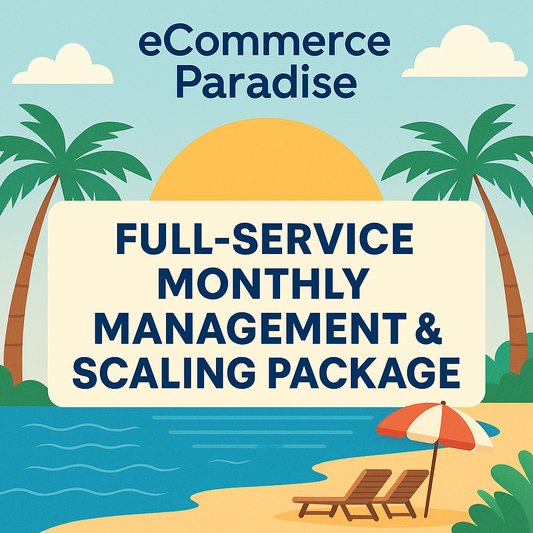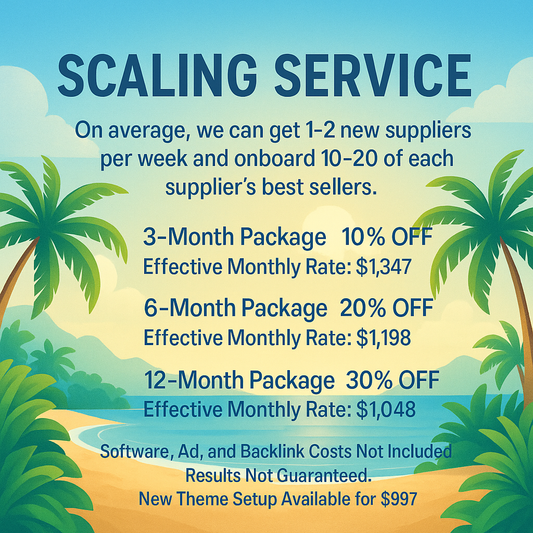
Common SEO Mistakes to Avoid in Your Shopify Store
As the founder of Ecommerce Paradise, I’m always thrilled to share insights that can help you effectively optimize your Shopify store for search engines. SEO, or Search Engine Optimization, is essential for anyone running an online store, especially in a competitive field like dropshipping. It not only boosts visibility on platforms like Google but can also enhance the performance of your Google Shopping Ads and Email Marketing efforts. However, many beginners make common SEO mistakes that can hinder their success. In this blog post, we’ll dive into these pitfalls and how to avoid them to maximize your ecommerce SEO strategies.
Understanding the Basics of SEO
Before we identify the mistakes, let's revisit what SEO means. In simple terms, it’s the practice of enhancing your website to rank higher in search engine results. A well-optimized website will attract more organic traffic, which can lead to increased sales. To achieve this, you need to focus on several key elements:
- Keyword Research
- On-Page SEO
- Technical SEO
- Content Quality
- Backlinks
Now that we’ve covered the basics, let's dive into some of the most common SEO mistakes you need to avoid with your Shopify store!
Ignoring Keyword Research
Many Shopify store owners dive into creating content or product listings without conducting thorough keyword research. This is a critical mistake! Understanding which keywords your target audience is using to look for products like yours is foundational for effective SEO.
How to Find the Right Keywords
Use tools like Google Keyword Planner, SEMrush, or Ahrefs to identify keywords with good search volume but low competition. Focus not only on generic terms but also on long-tail keywords that can help you rank higher.
Neglecting On-Page SEO
On-page SEO refers to the various optimizations you can implement directly on your website pages. Ignoring this aspect can limit your store's potential. Here are some vital components of on-page SEO that you should never overlook:
- Title Tags: Ensure that your title tags are unique, relevant, and contain your primary keywords.
- Meta Descriptions: Write compelling meta descriptions that entice users to click through to your store.
- Header Tags: Use header tags (H1, H2, H3, etc.) appropriately to structure your content. For example, each product page should have an H1 tag that includes the product name.
- Alt Text for Images: Optimize your image alt text with relevant keywords to improve accessibility and rankings.
- Internal Linking: Use internal links to guide users through your store and improve site navigation.
Overlooking Technical SEO
Technical SEO is equally essential when running a Shopify store. If your site is slow or has coding issues, search engines may penalize you. Here’s what to focus on:
Site Speed
Site speed is a ranking factor, and users are likely to abandon a slow-loading site. Use tools like Google PageSpeed Insights to check your store speed and implement changes to improve it.
Mobile Optimization
Ensure your Shopify store is mobile-friendly. A significant percentage of shoppers browse via mobile devices, and search engines prioritize mobile-optimized sites.
URL Structure
A clean and logical URL structure not only helps search engine crawlers but also enhances user experience. Use descriptive URLs that include relevant keywords. For example, instead of yourstore.com/product-page?id=123, use yourstore.com/women-s-running-shoes.
Producing Low-Quality Content
Content remains king in the realm of SEO. Producing low-quality content can hinder your ability to rank well. Always ensure your content is valuable, informative, and tailored for your audience. Here are a few tips to enhance content quality:
Value-Driven Content
Provide solutions to common problems, share tips, and educate your audience. Quality blog posts not only boost your SEO efforts but can also establish your brand as an authority in the ecommerce space.
Engaging Product Descriptions
Each product needs unique, engaging descriptions that resonate with visitors. Avoid the common mistake of using manufacturer descriptions; instead, showcase the value and benefits to the user. Use storytelling techniques where applicable—this can help enhance the overall shopping experience.
Neglecting Backlink Strategies
Backlinks are an important part of building your store’s authority. Many store owners either do not pursue backlinks or do so ineffectively. Here’s what you can do:
Building Relationships
Connect with bloggers, influencers, and other online businesses related to your niche. Guest posting on their sites can provide valuable backlinks and exposure.
Use of Social Media
Share your content across social media platforms. The more your content is shared, the higher the likelihood of earning backlinks. Plus, it can enhance your Email Marketing campaigns by driving interested traffic back to your site.
Forgetting About Local SEO
If you also have a physical presence or plan to attract local customers, don’t overlook local SEO! Here’s how to position yourself in local searches:
Google My Business
Create and optimize a Google My Business profile. This allows your Shopify store to show up in local searches and Google Maps, which can be beneficial for foot traffic and local credibility.
Local Keyword Optimization
Incorporate local keywords into your content and metadata to attract local customers. For instance, phrases like “best dropshipping store in [Your City]” can draw nearby searches.
Ignoring SEO Analytics
Failing to track and analyze your SEO performance can leave you in the dark about what works and what doesn’t. Regularly check your metrics to identify areas needing improvement.
Utilizing Google Analytics
Google Analytics provides insights about your website traffic. Pay attention to organic traffic trends, user behavior, and conversion rates. This data is invaluable for tweaking your strategies and enhancing your site’s performance.
SEO Tools
Consider leveraging tools like SEMrush or Moz to monitor backlinks, keyword performance, and site health. They can provide actionable insights that can elevate your ecommerce SEO game.
Not Staying Updated with SEO Trends
The SEO landscape is constantly evolving, and it’s crucial for business owners to stay informed about the latest trends. Search engines update their algorithms frequently, impacting rankings.
Follow SEO Blogs and Forums
Make it a habit to read reputable SEO blogs, attend webinars, and participate in forums. Keeping yourself updated will prepare you to adapt your strategies accordingly.
Emphasizing Quantity Over Quality
Last but not least, many store owners tend to think that publishing more content is better. However, a focus on quality over quantity will yield better results. One well-researched blog post is worth more than ten mediocre ones. Aim to create meaningful content that truly engages your audience.
Content Calendar
Create a content calendar that outlines your blog posting schedule, focusing on producing high-quality, valuable content at a manageable pace. This approach ensures that every piece of content is crafted with care, enhancing both SEO and user experience.
Your Path to SEO Success Awaits!
In the world of ecommerce and dropshipping, avoiding these common SEO mistakes can be the difference between a thriving Shopify store and one that struggles to get noticed. By dedicating time and effort to understanding the nuances of SEO, you can attract more visitors, boost your Google Shopping Ads performance, and elevate your Email Marketing strategies.
Remember, SEO isn’t a one-time effort but an ongoing process. Stay proactive, continually optimize your store, and endlessly evolve your strategy based on the new trends and insights you gather. Your ecommerce success story is waiting to be written—let’s make it a bestseller!


















